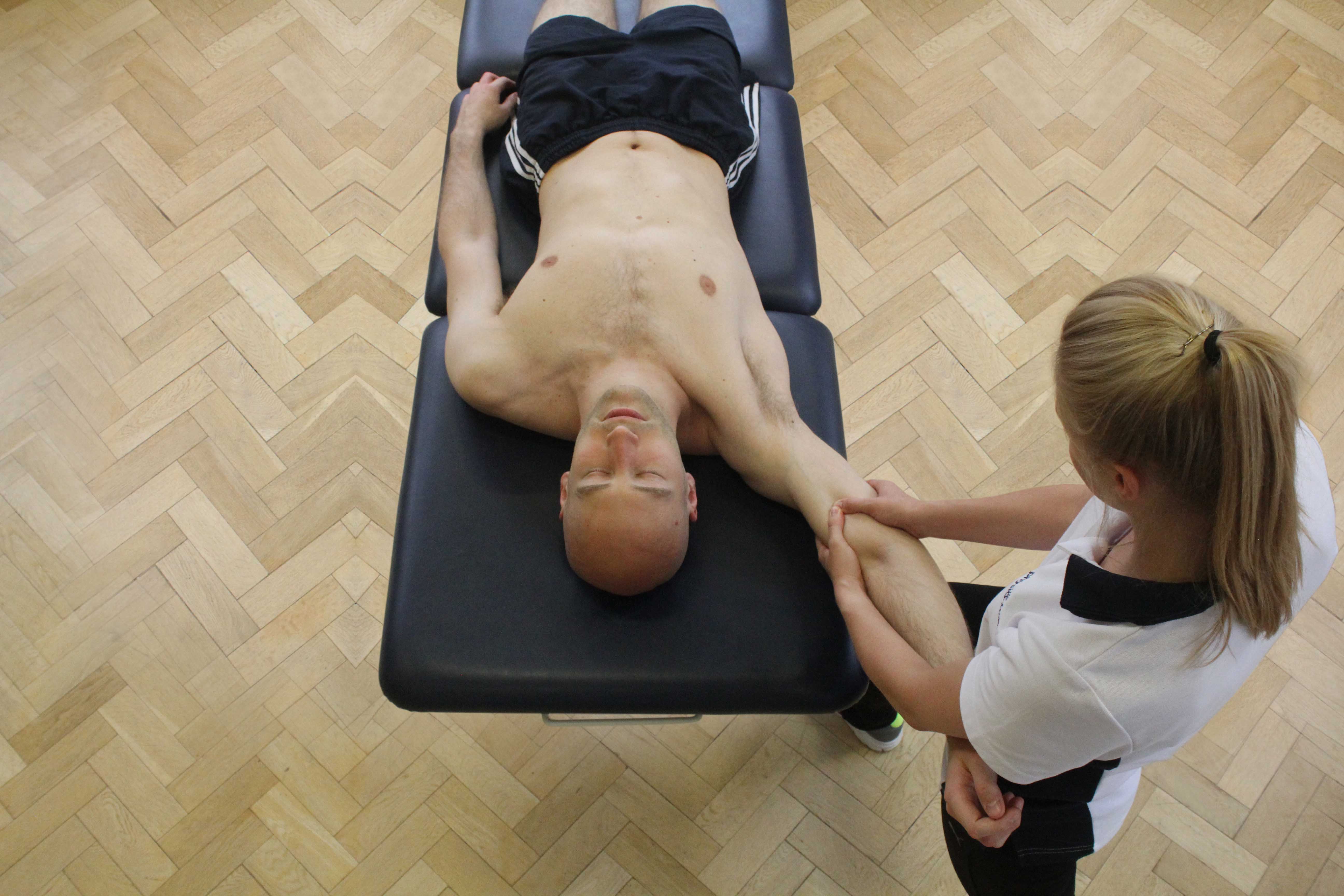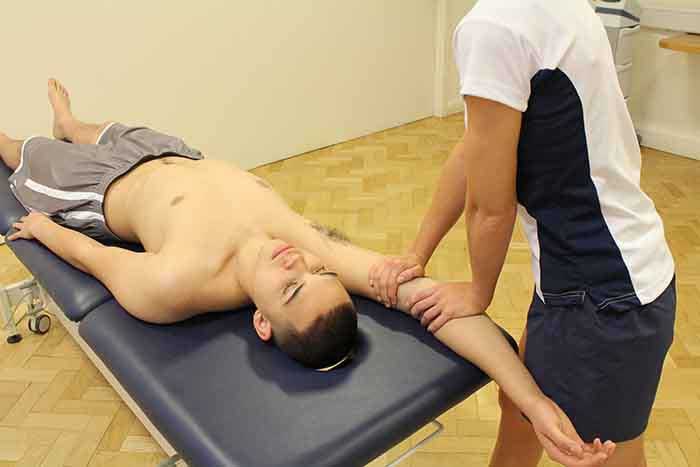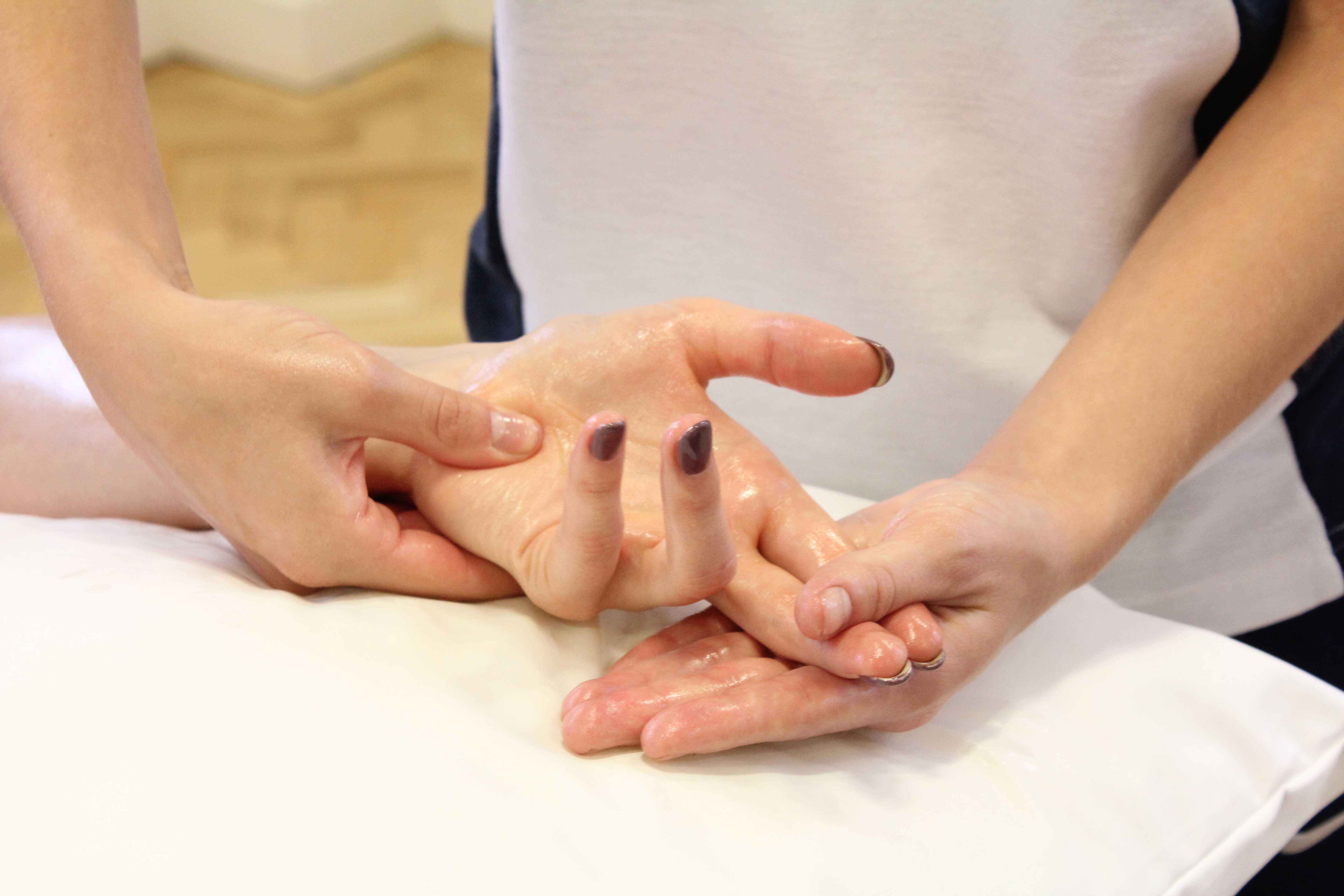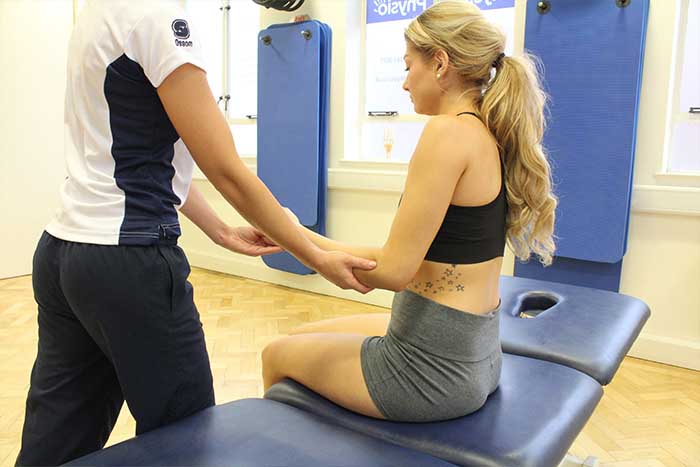Increased range of movement is a benefit often gained through massage. Increased range of movement can occur at both joints and muscles. When joints and muscles are stiff, tight and tense, movement is restricted and pain is increased. A massage aims to relieve muscle tightness. When muscles are relaxed and increased in flexibility, range of movement around a joint is increased. Our massage therapists at Physio.co.uk increase range of movement through massage to help improve performance, prevent injury and increase relaxation.
What are the most appropriate types of massage to increase range of movement?
A range of massage types can be used to increase range of movement. The most commonly used massage types used include:
 Above: Soft Tissue Massage targeting the bicep brachii muscle
Above: Soft Tissue Massage targeting the bicep brachii muscleThe most common massage types used to increase range of movement include deep tissue massage, remedial massage and therapeutic massage.
A deep tissue massage is often used to increase range of movement. A deep tissue massage concentrates on the deeper layers of muscles and tissues within the body. A deep, firm pressure is used during a deep tissue massage but the pressure can often vary depending on personal preference. Quite regularly, deep muscles become tight and tense causing restriction in movement and an increase in pain. A deep tissue massage aims to relax and loosen the tight muscles by increasing the tissue elasticity and flexibility. Loosening tight muscles reduces restriction and increases range of movement.

Range of movement can be increased through remedial massage. A remedial massage is used to treat both deep and superficial muscles. A remedial massage often creates a therapeutic effect through the manipulation of muscles. A remedial massage is most commonly used to stretch and loosen muscles by encouraging an increase in blood flow. An increase in blood flow helps to rise muscle temperature in order to relax muscles relieving tightness and tension. Relieving muscle tightness and tension allows a muscle to stretch to its full length with no restriction, therefore increasing range of movement.
A therapeutic massage can increase range of movement. A variety of techniques are used to treat and manipulate superficial muscles. Manipulation of muscles gives a therapeutic effect as this allows a person to physically and mentally relax. Muscles loosen and relax providing the physical relaxation and stress and anxiety due to restricted movement is reduced providing mental relaxation. Physical relaxation of muscles decreases restriction in movement therefore increasing range of movement.
What techniques are used to increase range of movement?
A variety of techniques can be used to increase range of movement. The most common techniques used to increase range of movement include:
 Above: Soft tissue massage of palma fascia
Above: Soft tissue massage of palma fasciaThe techniques most commonly used to increase range of movement include cupping, effleurage and kneading.
Cupping is a technique used to increase range of movement. Cupping can be performed using either plastic or glass cups. Cupping is specifically used to loosen fascia, tight muscles and improve lymphatic flow. Fascia is a layer of tough connective tissues located beneath the skins surface that regularly becomes tight and restrictive. Cupping lifts and stretches fascia and muscles, separating them both from each other. Stretching muscles and fascia reduces tissue inelasticity. Separating muscle from fascia helps to relieve restriction of movement within a muscle caused by fascia. Stretching muscles and reducing restriction both contribute to increasing range of movement.
Effleurage is an effective technique used to increase range of movement. Effleurage uses a range of pressures depending on the condition that is being treated and personal preference. Flattened hands and fingers are used during effleurage aiming to increase temperature of muscles by encouraging an improvement in blood flow. Increasing temperature of muscles improves tissue elasticity. When tissue elasticity is poor, movement is limited increasing pain and stress. Improving tissue elasticity reduces limited movement and relieves pain and stress, increasing range of movement.
Kneading is often used to increase range of movement. Kneading involves the squeezing and pulling of soft tissues. Kneading is a useful technique used to stretch connective tissues and improve blood flow. Stretching connective tissues increases their elasticity and flexibility to help increase movement. Improving blood flow provides muscles with healthy oxygen and nutrients. Movement is commonly restricted after an injury or surgery has occurred due to damaged muscles. Healthy oxygen and nutrients provided by an increase in blood flow are essential for the repair of damaged tissues and fibres. Improving blood flow speeds up recovery and increases range of movement more quickly.

When can a massage help to increase range of movement?
Increasing range of movement through massage can help in a range of situations. The situations most commonly helped through increased range of movement include:
The most common situations increased range of movement through massage can help include pre event, relaxation and tight muscles.
Increasing range of movement can help pre event. Before an event, muscles tend to be tight and tense due to intense training and preparation. When range of movement is poor, the chances of injury during the event are increased. Injuries such as muscle pulls strains and tears become more likely to occur. During a massage, muscle tightness and tension is reduced due to the encouragement of relaxation. Reduced muscle tightness and tension increases range of movement. An increase in range of movement allows muscles to stretch to their full potential during the event with reduced chances of injury.
Relaxation is increased when range of movement increases. When range of movement is poor due to tight or tense muscles, physical relaxation decreases. Stress levels increase due to pain and restriction in movement, reducing relaxation mentally. An increase in range of movement occurs during a massage due to increased tissue elasticity and flexibility which reduces muscle tightness and tension. A reduction in muscle tightness and tension allows a person to physically relax. When muscles are relaxed pain and restriction is also reduced. Reduced pain and restriction increases mental relaxation.
Tight muscles can be reduced by an increase in range of movement. Decreased range of movement is most commonly caused by tight muscles. Tight muscles can occur for a variety of reasons, the most common being poor posture, injury and over use. A massage encourages a reduction in tissue inelasticity. Reduced tissue inelasticity allows muscles to stretch and loosen. Loosened muscles increase range of movement and decrease tight muscles.
What are the physiological effects of massage to increase range of movement?
Various physiological effects occur during a massage to help increase range of movement. The most common physiological effects that occur include:
The physiological effects that most commonly occur during a massage to help increase range of movement include increased vasodilation, increased temperature and increased tissue elasticity.
Increased vasodilation can help increase range of movement. Vasodilation is where blood vessels widen and become closer to the skins surface. A massage encourages the release of a chemical called histamine. Histamine acts as a neurotransmitter which increases the permeability of blood vessels, encouraging the muscles lining the vessels to relax to therefore allow them to widen. Vasodilation allows an increase in blood to travel through the blood vessels helping to rise muscle temperature more quickly. A rise in muscle temperature is used to increase muscle flexibility and range of movement.
An increase in temperature occurs during a massage to help increase range of movement. An increase in temperature occurs at both superficial and deep tissues with the body and is used to help relax and loosen a muscle. The temperature of fascia can also be increased during a massage aiming to reduce restriction. Temperature is increased due to friction created between the skin and fingers which encourages an increase in blood flow. Increasing temperature reduces inelasticity of muscles and increases the capability of a muscle being able to stretch to its full range of movement.
Range of movement increases as tissue elasticity increases. Tissue elasticity is the capability of a muscle to stretch to reach is full range of movement with no restriction. Soft tissues and connective tissues are the most common types of tissue treated during a massage that often become tight and restrictive. Tissues can become tight and restrictive for a variety of reasons, the most common being overuse, injury and surgery. Temperature is increased during a massage increasing the flexibility of elastin fibres. Elastin fibres are what allow tissue to increase in elasticity. Increasing flexibility of elastin fibres.
Summary
Increased range of movement involves allowing a joint or muscle move and extend to its full range. A variety of massage types including deep tissue massage, remedial massage and therapeutic massage can be used to increase range of movement. Many techniques are used throughout a massage to increase range of movement including cupping, effleurage and kneading. Increasing range of movement through massage can help pre event, relaxation and tight muscles. A range of physiological effects including increased vasodilation, increased temperature and increased tissue elasticity all occur during a massage to help increase range of movement. Our massage therapists at Physio.co.uk increase range of movement through massage to help decrease pain and reduce restriction.
How can I arrange a massage to increase range of movement?
The easiest way to arrange a massage to increase range of movement at Physio.co.uk is to email us at office@physio.co.uk or call us on 0800 033 7800.
You can also book an appointment online and save £10

 0330 088 7800
0330 088 7800



































